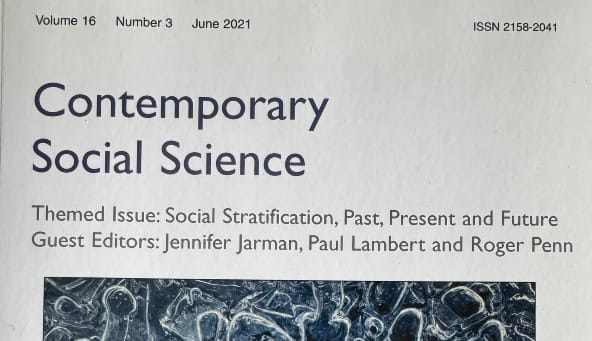Social Stratification: Past, Present, and Future

Editors: Jennifer Jarman, Paul Lambert, and Roger Penn
This is a special issue published in the journal of Contemporary Social Science. 16(3): pp. 271-415.
Editorial:
‘Social Stratification, Past, Present, and Future’ celebrates the 50th anniversary of the annual Cambridge Social Stratification Seminar. This editorial presents a brief characterisation of the ‘Cambridge school’ approach that has featured prominently throughout the seminar’s lifetime. Then it discusses the domains and topics explored in this issue – education; intergenerational transmission of inequality; family, work and employment; occupations; migration for work; housing, and political preferences. While most of the papers focus on Great Britain, several papers involve international comparisons; one focuses on stratification in India and another on China. Collectively, researchers reveal how social hierarchy influences people’s lives and reproduces in a stable manner over time. The papers also contribute to understanding the sometimes counter-intuitive outcomes that challenge those charged with policy development.
Connelly, R., Gayle, V., & Playford, C. (2021). Social class inequalities in educational attainment: measuring social class using capitals, assets and resources. Contemporary Social Science, 16(3), 280–293. https://doi.org/10.1080/21582041.2020.1805506
Part I: Education and the social stratification system
Connelly, R., Gayle, V., & Playford, C. (2021). Social class inequalities in educational attainment: measuring social class using capitals, assets and resources. Contemporary Social Science, 16(3), 280–293. https://doi.org/10.1080/21582041.2020.1805506
Gayle, V., Playford, C. J., & Connelly, R. (2021). Social class inequalities in Scottish school qualifications. Contemporary Social Science, 16(3), 294–308. https://doi.org/10.1080/21582041.2020.1823013
Stopforth, S., Gayle, V., & Boeren, E. (2021). Parental social class and school GCSE outcomes: two decades of evidence from UK household panel surveys. Contemporary Social Science, 16(3), 309–324. https://doi.org/10.1080/21582041.2020.1792967
Hillmert, S. (2021). Three spheres of stratification in how social origin relates to educational achievement: a large-scale analysis. Contemporary Social Science, 16(3), 325–343. https://doi.org/10.1080/21582041.2020.1794020
Traini, C. (2021). Like parents, like children. Does the stratification of education systems moderate the direct effect of origins on destinations? Contemporary Social Science, 16(3), 344–358. https://doi.org/10.1080/21582041.2020.1821908
Part II. Social stratification, work, internal migration and housing
Penn, R. (2021). New ways of exploring the changing nature of work: neglected themes in contemporary social stratification research. Contemporary Social Science, 16(3), 359–370. https://doi.org/10.1080/21582041.2020.1799065
Acharya, A. K. (2021). Caste-based migration and exposure to abuse and exploitation: Dadan labour migration in India. Contemporary Social Science, 16(3), 371–383. https://doi.org/10.1080/21582041.2020.1855467
Wu, Q. (Miranda). (2021). Social stratification and housing inequality in transitional urban China. Contemporary Social Science, 16(3), 384–399. https://doi.org/10.1080/21582041.2020.1797148
Part III: Broadening the analysis of social stratification
Richards, L., Heath, A., & Carl, N. (2021). Not just ‘the left behind’? Exploring the effects of subjective social status on Brexit-related preferences. Contemporary Social Science, 16(3), 400–415. https://doi.org/10.1080/21582041.2020.1847312